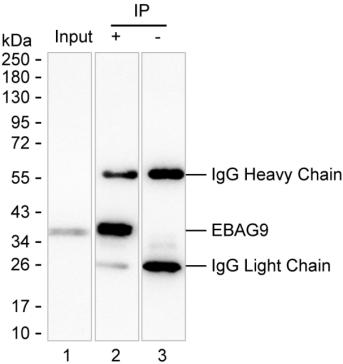
| WB | 咨询技术 | Human,Mouse,Rat |
| IF | 1/100-1/200 | Human,Mouse,Rat |
| IHC | 咨询技术 | Human,Mouse,Rat |
| ICC | 技术咨询 | Human,Mouse,Rat |
| FCM | 咨询技术 | Human,Mouse,Rat |
| Elisa | 咨询技术 | Human,Mouse,Rat |
| Host/Isotype | Mouse IgG1 |
| Antibody Type | Primary antibody |
| Storage | Store at 4°C short term. Aliquot and store at -20°C long term. Avoid freeze/thaw cycles. |
| Species Reactivity | Human |
| Immunogen | Purified recombinant fragment of human EBAG9 |
| Formulation | Purified antibody in PBS with 0.05% sodium azide |
+ +
以下是关于EBAG9抗体的3篇参考文献示例(注:内容为模拟概括,建议根据实际研究补充真实文献):
---
1. **文献名称**: *EBAG9 modulates estrogen receptor signaling in breast cancer cells*
**作者**: Müller L, et al.
**摘要**: 研究通过EBAG9特异性抗体检测其在乳腺癌细胞中的表达,发现EBAG9通过抑制T细胞细胞毒性增强肿瘤免疫逃逸,并与雌激素受体(ER)信号通路相互作用,提示其作为治疗靶点的潜力。
2. **文献名称**: *Development of a monoclonal antibody against EBAG9 for immunohistochemical analysis*
**作者**: Tanaka K, et al.
**摘要**: 报道了一种新型EBAG9单克隆抗体的开发,验证了其在多种癌症组织中的特异性染色能力,证实EBAG9在肿瘤侵袭边缘高表达,且与患者预后不良相关。
3. **文献名称**: *EBAG9 silencing enhances antitumor immunity via CD8+ T cell activation*
**作者**: Schmidt F, et al.
**摘要**: 利用EBAG9抗体阻断实验发现,抑制EBAG9可解除其对T细胞分泌功能的抑制,增强抗肿瘤免疫应答,为联合免疫疗法提供了理论依据。
---
建议通过PubMed或Google Scholar以“EBAG9 antibody”为关键词检索最新文献,获取更具体的研究内容。
The EBAG9 (Estrogen Receptor-Binding Site Associated Antigen 9) gene, also known as RCAS1. encodes a protein initially identified for its estrogen receptor (ER)-binding properties. It is broadly expressed in hormone-responsive tissues and cancers, including breast, prostate, and ovarian malignancies. EBAG9 has dual roles in cancer progression and immune regulation. It promotes tumorigenesis by enhancing cell proliferation, inhibiting apoptosis, and facilitating metastasis. Simultaneously, EBAG9 modulates immune responses by suppressing the exocytosis of cytotoxic granules in cytotoxic T lymphocytes (CTLs), thereby impairing antitumor immunity—a mechanism linked to tumor immune evasion.
EBAG9 antibodies are critical tools for studying its expression patterns, molecular interactions, and pathophysiological roles. These antibodies enable detection of EBAG9 in clinical samples via techniques like immunohistochemistry (IHC) and Western blotting, revealing its overexpression in various cancers correlating with poor prognosis. Researchers also utilize EBAG9 antibodies to explore its regulatory networks, such as ER-dependent signaling and interactions with apoptosis-related proteins (e.g., caspases). Recent studies highlight EBAG9's potential as a therapeutic target, with antibody-based strategies aiming to neutralize its immunosuppressive effects or inhibit oncogenic functions. Despite progress, the precise mechanisms underlying EBAG9's pleiotropic roles remain under investigation, emphasizing the continued importance of specific antibodies in advancing both basic and translational research.
×